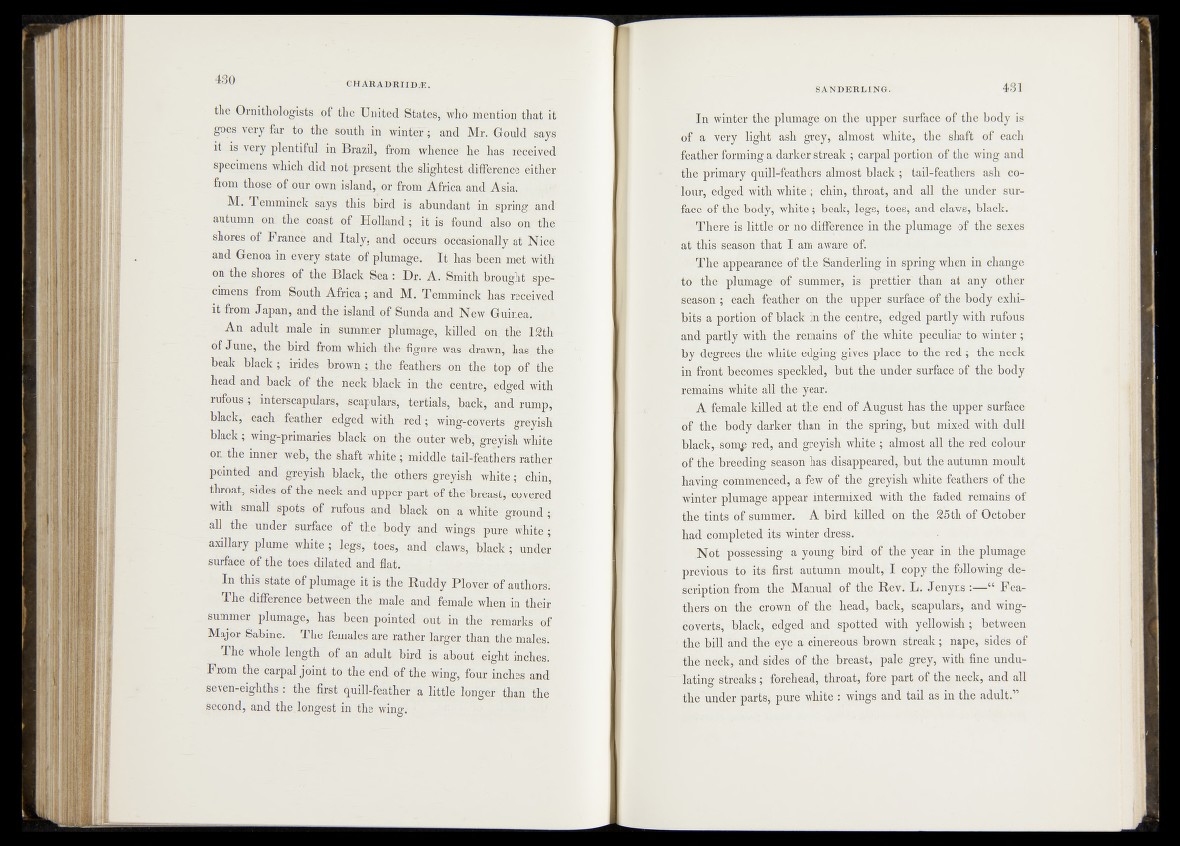
the Ornithologists of the United States, who mention, that it
goes very far to the south in winter; and Mr. Gould says
it is very plentiful in Brazil, from whence^ he has received'
specimens which did not~present the slightest difference either
from those of our own island, or from Africa and Asia.
M. Temminck says this Sit'd is abundant in spring and:
autumn o il the coast of Holland; it is found_a!so on- the,
shores of France and Italy, and occurs vOecasionally at Ni<||
and Genoa in every state of plumage. It has been met with"
on the shores of the Black Sea: Dr. A. Smith brought specimens
from South Africa; and M. Temminck has received
it from Japan, and the island of SuOda and New Guinea.
An adult male in summer plumage, killed on;, the 12th-
of June, the bird from which.-the figure was drawn, lias..the
beak black; irides ^owfr_Lthe feathers-on‘the'top' of-the
head and back: of the neck black in the centre,-edged with
rufous;:; interscapulars, scapulars, tertials, back, jkd rump,
black, each feather edged with red; wing-coverts greyish’
black ; wing-primaries black on the Outer we^greyish w^te
on^the inner web, the shaft white * middle taS-fea there rather
pointed and greyish black, the otherstgreyish .j$$|e!;4>hm,
throat, sides of the neck and upper part of the'breast, covered
With small spots of rufous and- black on' a w h ite% ^ iid §
all the-under surface of the body and-wings“ pure wTife;-
axillary plume white; legs;'toes, and claws, black'; under
surface of the toes dilated and flat.
In this state of plumage it is the Ruddy Plover of authors!!
The difference between the male and female when in tgeir
summer plumage, has been pointed out in the remarks of
Major Sabine. The females are rather larger than the males.
The whole length of an adult bird is about eight inches.
From the carpal joint to the end. of the wing, four inches and
seven-eighths: the first quill-feather a little lunger than th£
Second, and the. longest in the wing. •
In winter the plumage on the upper surface of the body is
of a very light ash grey, almost white, the shaft of each
feather forming a darker streak ; carpal portion of the wing and
the primary qtip-feathers almost black-; tail-feathers ash colour,
edged with white ; chin, throat, and all the under surface
of the wM*tib; beak, legs;- toesv and claws, black.
There is lit|f§ or no difference in the plumage of the sexes
at this seasohthat I am aware of.
- ■ 'The appearance of the Sanderling in spring when in change
to the -plumage summer^-|^piettier' than at any other
season ; each feather oh thSftpper shrface-of the-body eshi-
bits a pqpt&| of black jn thd centre, edged partly with rufous
and .partly with tile remains-of the white peculiar to winter;
|ly degrees*the white edging giwes place^td the red ; the neck
in front bëcgnaél speckled,- but the under surface of the body
rèmains whitè1 a|l||hëtyear.
A female killed at the end of At%ifet$has* the upper surface
of dneV'b0dy: darker.’thanlMithc .spring,' BMfndx«*d%ifh dull
black-r som£ red;, and;greyish white- almost -all the red' ctlour
of the-lfee'dih^ seasl»'hasfdisappearedv but the autumn moult
ha^g^Commenced, a few of the greyish wlitljgleathers of the
Mntef'jplumage appear intermixed»?with thewfadred^ remains of
the tin t^ ^ nm m é r.- A bird killedfon1 th e ^ ö th of October
had completed its winter dress.
.Not possessing a young bird pfe the year in the plumage
to its first autiimn moult,i?lL%b.|?y;th:e following de-r
.O p tio n from the-Manual of flfë Rev. L. Jenyns :—“ Feathers
on the crown of the head, back, scapulars, and wing-
é'överts, black, edgéd^krd: ,spotted with yellowish; between
'the bill and the eye a-cinereous-brown streak; nape, sides of
the neck, and-- sides- of the .breast, pale grey, with fine undulating
streaks; forehead, throat, fore part of the^neck, and all
the under parts, pure white ; wings and tail as in the adult.”